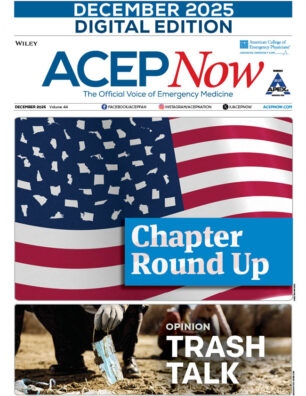I would like to respond to Dr. David Baehren’s colum titled “Let My People Go” (April 2012, p. 2). I’ve been an ED clinician and an ED Director, each as a hospital employee and as a member of an independent, self-billing EM group. Also, for over a dozen years I was the managing partner of a regional EM group, responsible for contracting with payers and facilities, and for billing/collections.
Explore This Issue
ACEP News: Vol 31 – No 06 – June 2012I understand the feelings expressed by Dr. Baehren, the pain and the emotion. However, there is no “taking” of services from emergency physicians under EMTALA. EMTALA squarely places the primary medical screening exam and stabilization mandate on hospitals. Hospitals can satisfy this obligation in three basic ways:
- Having their employees (including practitioner employees) perform the necessary services as part of their employment duties; or
- Obligating (i.e., transferring all or part of the obligation via hospital rules/regulations) certain practitioners or groups of practitioners to perform the necessary duties; or
- Contracting with certain practitioners or groups of practitioners to perform the necessary duties.
The first is a straightforward employment arrangement, and the employee can choose to accept the conditions of employment or not (and thereby not be employed at that hospital).
The second again presents the practitioner with a choice of abiding by the hospital’s rules/regs (presuming they’ve been appropriately drafted and approved) or not being on staff at that institution.
The third, the one Dr. Baehren apparently finds himself in along with many other emergency physicians, is a contractual issue – that is, the hospital offers or counteroffers a contract with certain terms (e.g., performance of EMTALA obligations, participation with specified payers), and the practitioner entity asks for certain operational (including sometimes financial) terms. And both sides have to agree upon all the contractual terms in order for there to be a contract. I have heard people rail about “contracting under duress” or “coercive contracting.” And it’s true that a contract signed under duress is unenforceable. However, having to leave a hospital or a community due to the absence of a contract is not deemed to meet the legal definition of duress, at least not to my knowledge. In general, entities fail to contract and contracts terminate every day.
While it’s true that hospitals usually are able to wield a greater amount of power than the EM practitioners in contract discussions, that’s not a product of EMTALA. Rather it’s the result of how the business of hospitals and emergency medicine has evolved to this point.
Dr. Peter L. Sawchuk, JD, MBA
Lake Havasu City, Ariz.
Pages: 1 2 | Multi-Page




No Responses to “Whose EMTALA Is It, Anyway?”